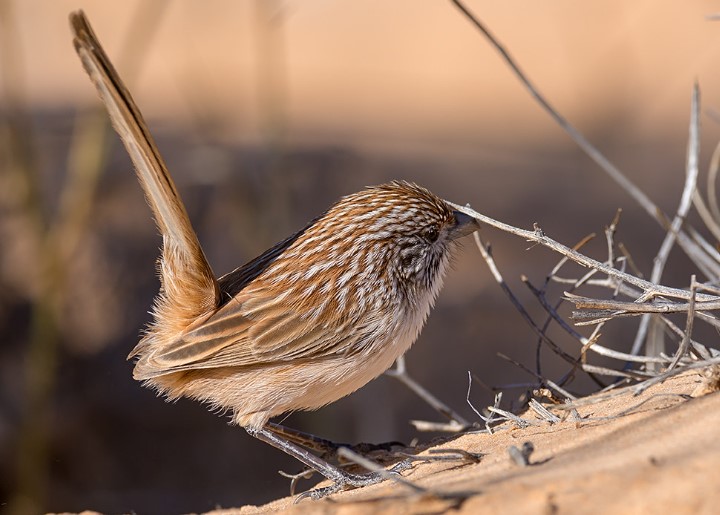Habitat: The lovely fairywren (Malurus amabilis) lives far more in trees than other Australian fairywrens, reflecting their habitat: scrubby rainforest and its edges. Although they occasionally drop to the forest floor, they spend most of their time foraging in groups among bushes and leafy branches of saplings and trees up to 20 meters above the ground.
Their rather short, white-tipped tails are carried upright and often slightly fanned as birds hop about the foliage, snatching insects as they move. Family parties comprise up to seven birds: the dominant pair and their young of the year. Most disperse before the next breeding season. Once attaining nuptial plumage, the dominant male never molts out of it. Several of them gather at one time, hopping about as females, carrying yellow petals in courtship.
Vocalization: The Lovely Fairywren call is a single, whistled, insect-like sound—a soft churr in alarm. The song consists of a short musical trilling warble, descending slightly, without introductory chirps.
Identification: MALE: Crown, mantle, and ovate ear coverts azure-blue; lores, nape collar, lower back, throat, and breast black; scapular patches rich chestnut; wings dusky black, inner flight feathers edged rufous; tail blue, very broadly tipped white; belly white. Eyes are brown. The bill is black. Feet are mid-flesh-grey
The female crown to lower back is smoky blue; the wings are dark grey; the tail is smoky blue, broadly tipped white; the lores are white, ringing eyes in a mask; the ear patches are turquoise-blue. Eyes, bill, and feet as the male. The immature bird is duller and grayer. Males may attain nuptial plumage in the first year, depending on social status.
Nesting and breeding: In their tropical habitat, lovely fairywrens may breed at any time. Unaided, the female takes up to 10 days to construct the nest. Eggs are laid successively and incubated by the female once the clutch is finished. Although helped by others in their group. She usually carries most of the burden of feeding the young as well. The brush cuckoo parasitizes the lovely fairywren’s brood. Nesting and breeding occur year-round. Peak months are July and December. Nest is a coarse dome with a side entrance, about 13 x 9 cm, of grass and skeletonized leaves, lined with feathers, fur, fine grasses, and bark, within 1 meter of ground in dense undergrowth.
Eggs and Incubation: The bird lays two to four eggs, usually three; they are creamy white and lightly speckled with red-brown at the larger end. The incubation period is approximately 13 days for females. Young fledge in about 12 days.
Similar species: As a member of the chestnut-shouldered fairywren genus, it belongs to a group of five other species that are very similar, collectively known as chestnut-shouldered fairywrens. There are four more species of fairywren: the variegated fairywren, the purple-backed fairywren, the red-winged fairywren, and the blue-breasted fairywren.
Alternative Name: It is also known as the Lovely Wren
Size: Lovely Fairywren is 120–130 mm long.
Diet: Fairywrens are insectivorous, eating insects, including caterpillars.
Distribution: Lovely Fairywren is found in coastal Cape Kirk Peninsula south to near Townsville, in the margins of rainforest and associated brush.







